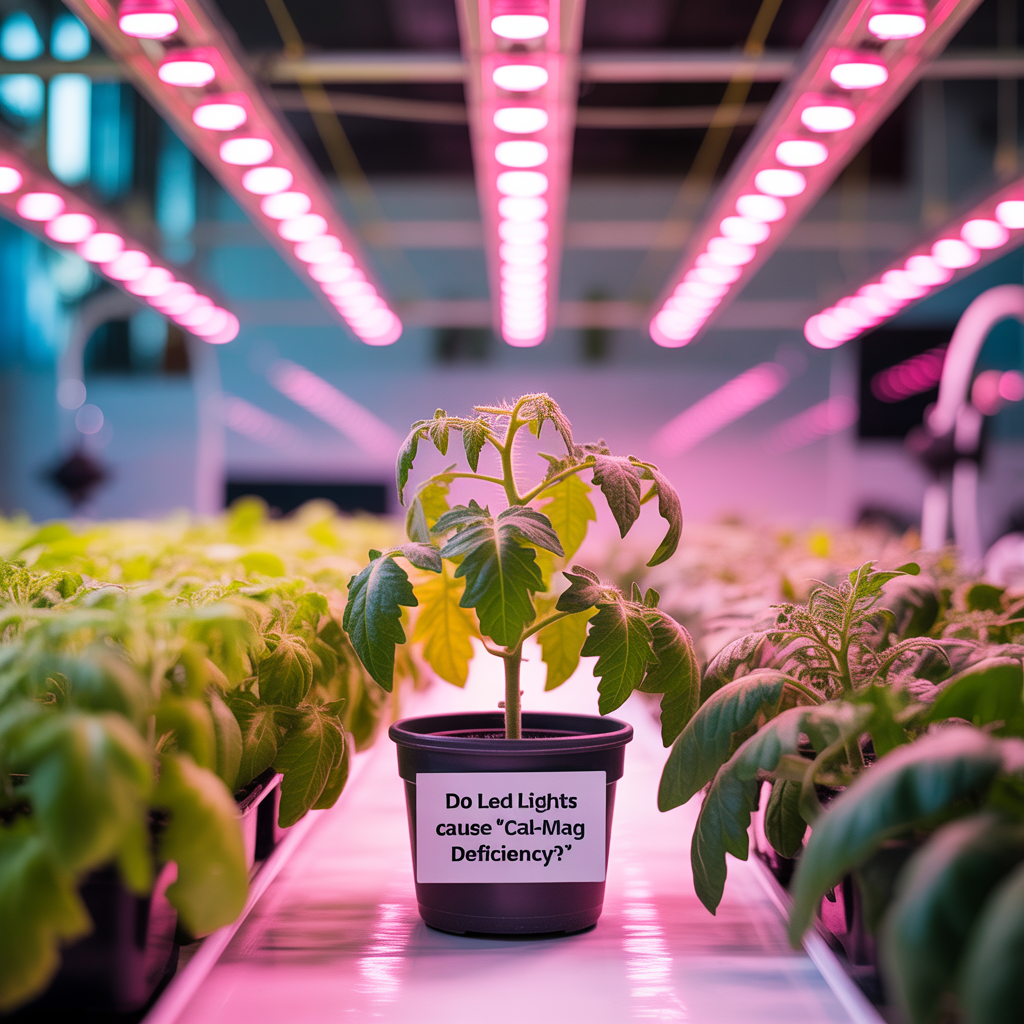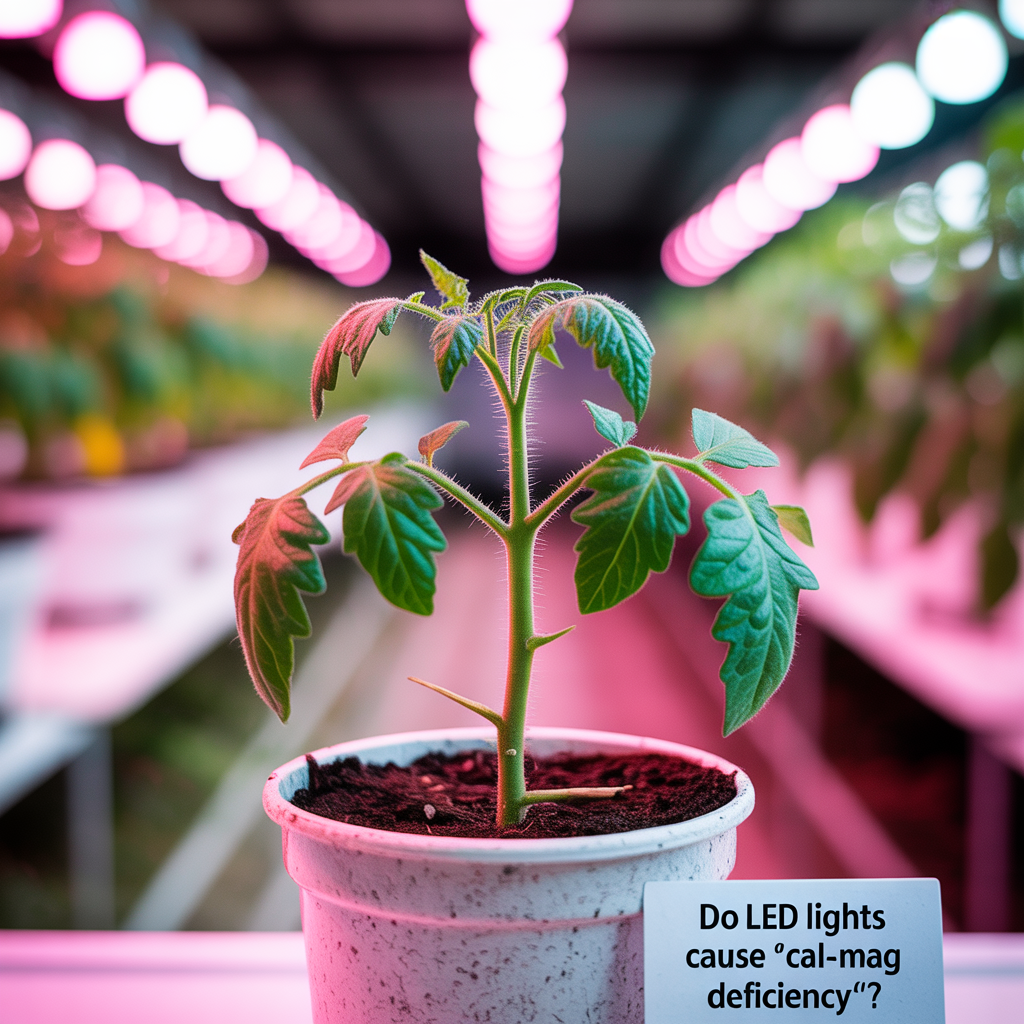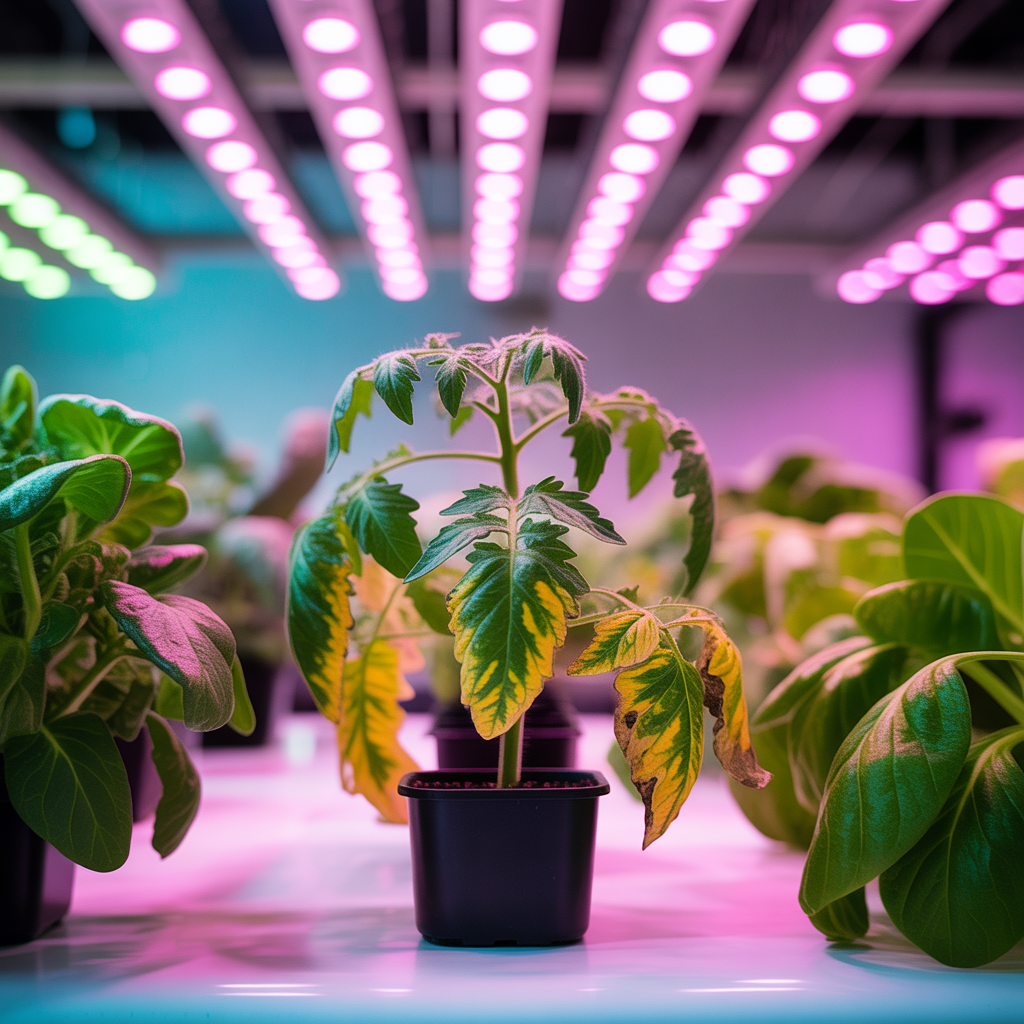Do LED Lights Cause Cal-Mag Deficiency? A Complete Discussion
Do LED lights cause cal-mag deficiency? LED lights do not directly cause calcium-magnesium (cal-mag) deficiency, but their intense light spectrum can increase plant growth rates, which may raise nutrient demands. If cal-mag levels in the soil or hydroponic solution aren’t adjusted, deficiency symptoms may appear under LEDs. Proper nutrient balance prevents this issue. Calcium and…
Do LED lights cause cal-mag deficiency? LED lights do not directly cause calcium-magnesium (cal-mag) deficiency, but their intense light spectrum can increase plant growth rates, which may raise nutrient demands. If cal-mag levels in the soil or hydroponic solution aren’t adjusted, deficiency symptoms may appear under LEDs. Proper nutrient balance prevents this issue.
Calcium and magnesium are essential macronutrients for plant growth. Calcium plays a crucial role in cell wall formation, providing structural integrity. Magnesium is a central component of chlorophyll, the molecule responsible for photosynthesis. Deficiencies in either nutrient can significantly impact plant health and yield.
Calcium deficiency often manifests as stunted growth, deformed young leaves (hook-shaped or curled), blossom-end rot in fruits, and necrotic lesions (dead tissue) at the tips and edges of leaves.
Do LED Lights Cause Cal-Mag Deficiency?
Magnesium Deficiency Symptoms

Magnesium deficiency typically results in interveinal chlorosis (yellowing between leaf veins), which can progress to leaf necrosis. Older leaves are typically affected first because magnesium is a mobile nutrient.
Read More: Do LED Lights Attract Spiders? The Official Answer For You
The Role of Light in Nutrient Uptake
Light plays a vital role in plant nutrient uptake. Photosynthesis, the process by which plants convert light energy into chemical energy, is crucial for nutrient assimilation and transport. The energy generated during photosynthesis powers the active transport of nutrients into plant cells.
The Impact of Light Intensity
Insufficient light intensity can reduce the rate of photosynthesis, impacting nutrient absorption. Plants under low-light conditions may struggle to uptake sufficient calcium and magnesium, even if these nutrients are present in the growing medium.
The Importance of Light Spectrum
Different wavelengths of light influence different aspects of plant growth and development. While LEDs offer a broad spectrum, the balance of red, blue, and far-red light influences nutrient uptake and utilization. An improper balance can disrupt plant physiology.
LED Grow Lights and Nutrient Deficiencies
While LEDs are highly efficient and offer precise light spectrum control, they don’t inherently cause calcium-magnesium deficiency. However, improper use of LED grow lights can create conditions that indirectly contribute to deficiencies.
Incorrect Light Spectrum
An unbalanced light spectrum, particularly a lack of far-red light, can negatively influence the plant’s ability to transport nutrients, potentially leading to deficiencies. This is more likely with poorly designed or improperly configured LED systems.
Light Intensity Issues
Insufficient light intensity, even with the correct spectrum, can restrict photosynthesis and hinder nutrient uptake. Plants grown too far from the LED light source, or with insufficient lighting power, might experience nutrient deficiencies.
Environmental Factors
LED lights themselves are not the primary cause, but their contribution to environmental factors can indirectly affect nutrient uptake. For example, extremely high light intensity can increase transpiration, depleting the plant’s water supply and potentially affecting nutrient mobility within the plant.
Read More: Do LED grow lights work? Do They Actually Work? A Comprehensive Guide
Diagnosing Calcium and Magnesium Deficiencies

Accurate diagnosis is crucial for effective treatment. This involves careful observation of symptoms, as well as testing the growing medium and plant tissue for nutrient levels.
Visual Symptoms
Look for the characteristic symptoms of Ca and Mg deficiencies as described earlier. Comparing affected plants to healthy ones can aid in diagnosis.
Nutrient Testing
Soil or hydroponic solution testing can reveal nutrient levels. Leaf tissue analysis provides a more precise assessment of nutrient status within the plant itself.
Read More: 15 Creative Exposed Ceiling Lighting Ideas | Don’t Miss
Remediating Calcium and Magnesium Deficiencies

Treating calcium and magnesium deficiencies requires addressing the underlying cause and supplying the missing nutrients.
Nutrient Supplements
Application of calcium and magnesium supplements, in liquid or granular form, is often the most direct solution. Follow product instructions for application rates.
Adjusting Growing Conditions
Ensure adequate light intensity and a balanced light spectrum. Address issues with watering, pH balance, and other environmental factors that might hinder nutrient uptake.
Improving Growing Media
The growing medium’s ability to retain and release nutrients affects availability to the plant. Using an appropriate growing medium with good drainage and air pockets can positively impact nutrient uptake.
Preventing Calcium and Magnesium Deficiencies
Prevention is always better than cure. By taking proactive measures, you can greatly reduce the risk of deficiencies.
Nutrient-Rich Growing Media
Begin with a high-quality growing medium that provides adequate calcium and magnesium. Amendments such as dolomite lime can be added to improve nutrient availability.
Regular Nutrient Monitoring
Monitor nutrient levels regularly through testing and visual observations. This allows for early detection of any potential deficiencies.
Proper Lighting and Environmental Control
Ensure the proper distance, intensity, and spectrum of light for your plant species and growth stage. Maintain appropriate temperature, humidity, and watering schedules.
The Influence of Other Factors
Beyond LED grow lights, other factors can contribute to or exacerbate calcium and magnesium deficiencies.
pH Levels
Soil pH has a considerable influence on nutrient availability. An improper pH can lock up calcium and magnesium, making them unavailable for plant uptake.
Watering Practices
Overwatering or underwatering can negatively affect nutrient uptake. Consistently moist, well-drained soil is ideal.
Nutrient Interactions
Certain nutrient imbalances can interfere with calcium and magnesium uptake. Excessive levels of potassium or phosphorus can compete with the absorption of calcium and magnesium.
Comparing LED Grow Lights to Other Light Sources
Let’s compare LEDs to traditional grow lights, such as High-Pressure Sodium (HPS) and Metal Halide (MH) lamps.
LEDs vs. HPS/MH
LEDs offer better energy efficiency, a broader spectrum control, and longer lifespan compared to HPS and MH lamps. However, the initial cost of LED setups can be higher.
Light Spectrum Variations
HPS lamps tend to favor the red and orange spectrum, while MH lamps offer a more balanced spectrum. LEDs allow for precise customization, ensuring the optimal spectrum for the specific plants grown.
Troubleshooting Common Issues
Let’s tackle some common problems growers encounter related to LED grow lights and nutrient deficiencies.
Burned Leaves
Too high light intensity from LED lights can cause leaf burn. Increase the distance between the lights and the plants to rectify.
Stunted Growth Despite Adequate Nutrients
This could indicate insufficient light intensity or an incorrect light spectrum impacting photosynthesis and nutrient uptake.
Uneven Growth
Uneven light distribution due to poorly positioned LED lights can cause uneven growth patterns. Rearrange your lights for uniform coverage.
Choosing the Right LED Grow Lights
Selecting appropriate LED grow lights is paramount for optimal plant growth and nutrient availability.
Spectrum Considerations
Choose LEDs that offer a balanced spectrum, including sufficient red, blue, and far-red light, mimicking natural sunlight as closely as possible.
Light Intensity and Coverage
Ensure the LEDs can provide adequate light intensity for your plants’ needs and cover the entire growing area evenly.
Budget Considerations
Set a realistic budget, balancing quality and affordability. Consider long-term costs, including energy consumption and lifespan.
FAQ
What are the most common symptoms of calcium deficiency in plants?
Calcium deficiency often manifests as stunted growth, deformed young leaves, blossom-end rot in fruits, and necrotic lesions at the tips and edges of leaves. These symptoms primarily affect actively growing tissues because calcium is a relatively immobile nutrient.
How does magnesium deficiency affect plant photosynthesis?
Magnesium is a critical component of chlorophyll, the molecule responsible for photosynthesis. A magnesium deficiency reduces chlorophyll production, leading to a decrease in the plant’s ability to convert light energy into chemical energy, ultimately affecting growth and yield.
Can LED grow lights directly cause calcium-magnesium deficiency?
No, LED grow lights don’t directly cause calcium or magnesium deficiency. However, improper use of LEDs, such as incorrect light spectrum, insufficient light intensity, or uneven light distribution, can create environmental conditions that hinder nutrient uptake and contribute to deficiencies.
What are the best ways to test for calcium and magnesium deficiencies?
Visual inspection for characteristic symptoms is a crucial first step. Further diagnosis involves soil/hydroponic solution testing and plant tissue analysis (leaf testing) for precise quantification of nutrient levels.
What is the best way to apply calcium and magnesium supplements?
Follow the product instructions. Liquid supplements are usually readily absorbed, while granular supplements can be incorporated into the growing medium. Application methods vary depending on the growing system (soil, hydroponics, etc.).
How can I prevent calcium-magnesium deficiencies using LEDs?
Proper light intensity and spectrum are key. Use a balanced spectrum LED system with sufficient light intensity for the plant’s growth stage and species. Monitor nutrient levels regularly, use a suitable growing medium, and maintain optimal growing conditions.
What role does pH play in calcium and magnesium availability?
Soil pH significantly impacts nutrient availability. A pH outside the optimal range for a particular nutrient can render it unavailable for plant uptake. Optimizing pH is critical for ensuring that calcium and magnesium remain available to the plants.
Final Thoughts
While LED grow lights themselves do not directly cause calcium and magnesium deficiencies, improper usage can create conditions that indirectly lead to these deficiencies. Understanding the roles of light intensity, light spectrum, and other environmental factors in nutrient uptake is vital for successful indoor gardening. By carefully monitoring nutrient levels, employing proper growing techniques, and selecting appropriate LED grow lights, you can successfully cultivate healthy plants and maximize yields. Remember, preventing deficiencies through proactive measures is always the most effective approach. Invest in high-quality LED grow lights and diligently monitor your plants’ nutritional needs to achieve optimal growth and abundant harvests.

